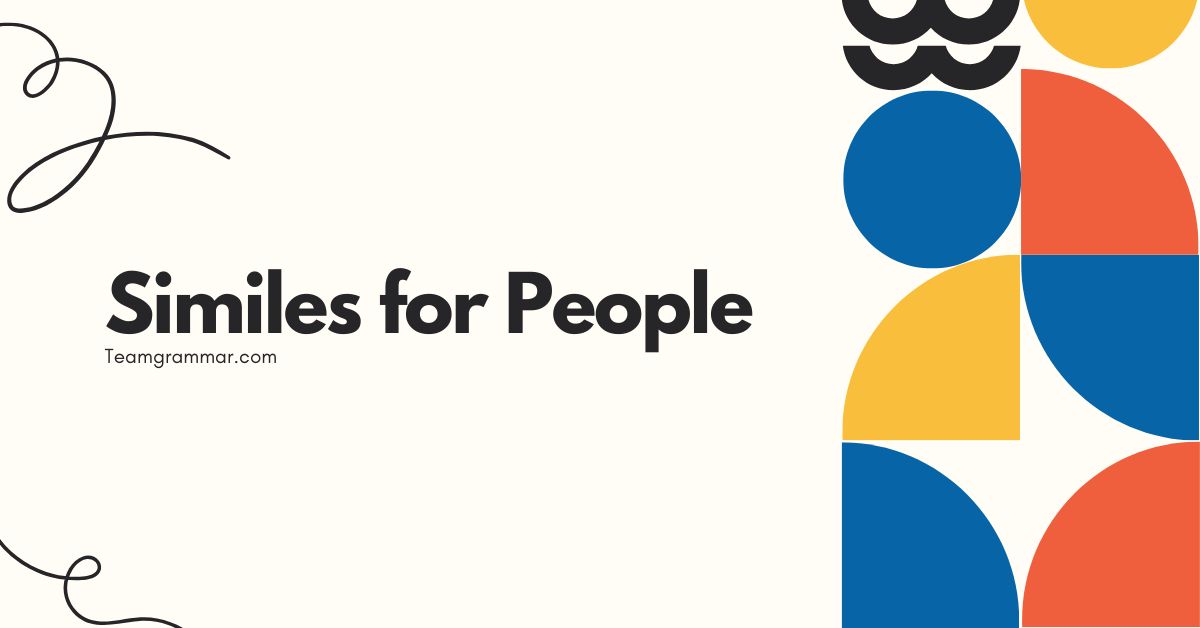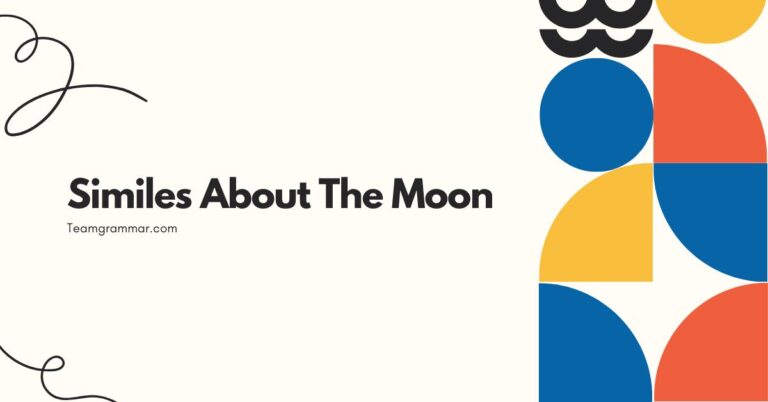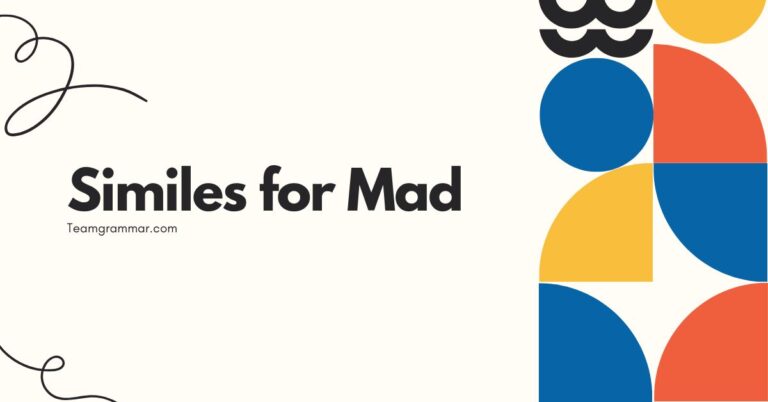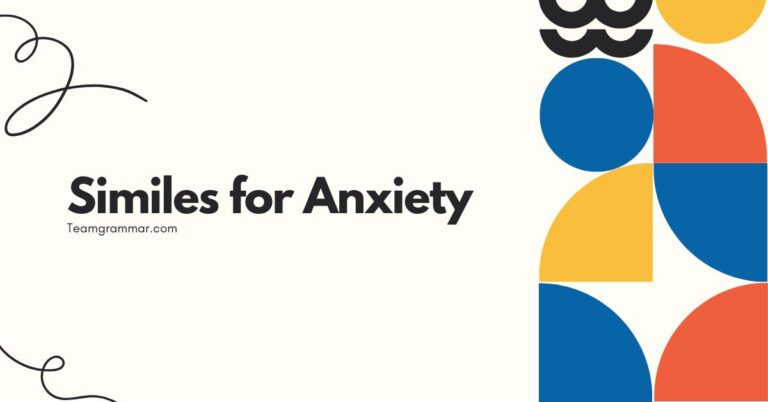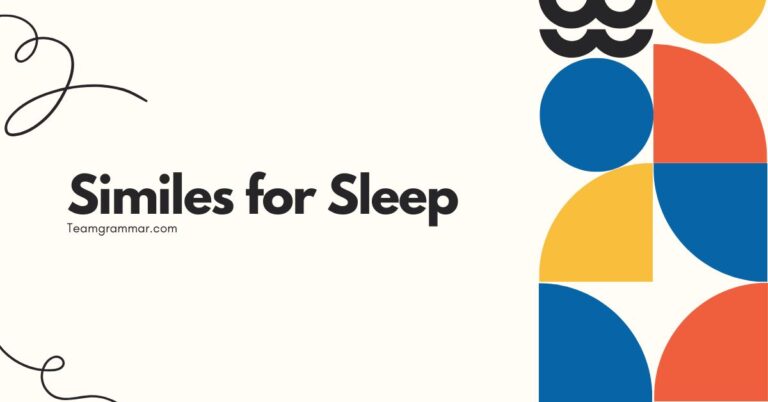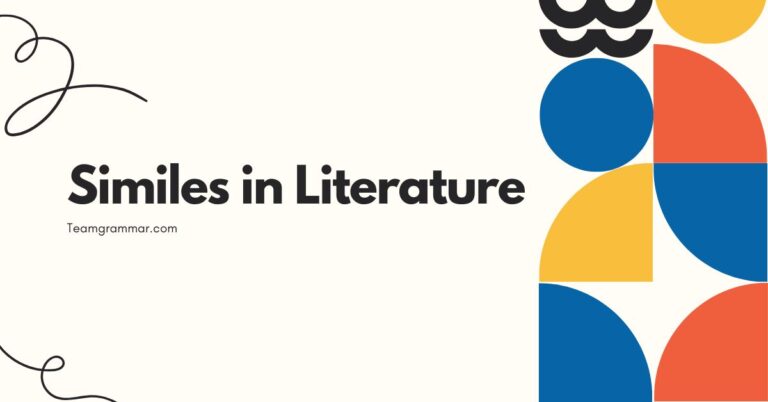35 Similes for People: Mastering Figurative Language
Understanding similes is crucial for enhancing your descriptive writing and communication skills. Similes, a type of figurative language, allow you to draw comparisons between people and other entities, adding depth and vividness to your descriptions.
This article will thoroughly explore the concept of similes as they relate to describing individuals, covering everything from their basic definition and structure to advanced usage and common pitfalls. Whether you’re a student, writer, or simply someone looking to improve your English proficiency, this guide will equip you with the knowledge and tools to effectively use similes in your everyday language.
By the end of this article, you will not only understand what similes are but also how to construct and use them effectively to create compelling and memorable descriptions of people. We’ll delve into various types of similes, explore numerous examples, and provide practical exercises to solidify your understanding.
Get ready to unlock the power of figurative language and elevate your writing to new heights!
Table of Contents
- Definition of Simile
- Structural Breakdown of Similes
- Types and Categories of Similes
- Examples of Similes for People
- Usage Rules for Similes
- Common Mistakes with Similes
- Practice Exercises
- Advanced Topics in Similes
- Frequently Asked Questions
- Conclusion
Definition of Simile
Asimileis a figure of speech that directly compares two different things using the words “like” or “as.” The purpose of a simile is to highlight a shared quality or characteristic between the two entities being compared, thereby creating a more vivid and relatable image or understanding. Similes are a powerful tool in writing and speech, enabling you to convey complex ideas or emotions in a more accessible and engaging manner.
They are often used to add color, depth, and nuance to descriptions, making them more memorable and impactful.
In the context of describing people, similes can be particularly effective. By comparing a person to something else, you can quickly and effectively communicate their personality, appearance, or behavior.
For example, saying someone is “as brave as a lion” immediately conveys their courage and fearlessness. The effectiveness of a simile lies in the reader’s or listener’s ability to understand and relate to the comparison being made.
The more familiar and relatable the comparison, the more powerful the simile becomes.
Similes are different from metaphors. While both are figures of speech that draw comparisons, a simile uses “like” or “as” to explicitly state the comparison, whereas a metaphor implies the comparison without using these words.
For instance, “He is like a rock” is a simile, while “He is a rock” is a metaphor. Understanding this distinction is crucial for using each figure of speech correctly and effectively.
Similes are versatile and can be used in various contexts, from formal writing to casual conversation.
Structural Breakdown of Similes
The structure of a simile is relatively straightforward, typically consisting of three main components: the subject being described, the connecting word (“like” or “as”), and the object or idea to which the subject is being compared. Understanding this structure is essential for constructing clear and effective similes.
Let’s break down each component in detail:
- Subject: This is the person or thing that you are describing. It’s the focus of the simile and the entity whose qualities you want to highlight. For example, in the simile “She is as graceful as a swan,” the subject is “She.”
- Connecting Word: This is the word that establishes the comparison. It’s either “like” or “as.” This word signals to the reader or listener that a comparison is being made. Using the correct connecting word is crucial for clarity.
- Object of Comparison: This is the person, thing, or idea to which the subject is being compared. It’s the entity that shares a similar quality or characteristic with the subject. In the example “He is as strong as an ox,” the object of comparison is “an ox.”
The order of these components can sometimes be varied for stylistic effect, but the core elements remain the same. For example, instead of saying “He is as quick as a fox,” you could say “As quick as a fox, he darted through the crowd.” While the structure is altered, the meaning and components of the simile remain intact.
Consider the following table that illustrates the structural breakdown of similes with examples:
| Simile | Subject | Connecting Word | Object of Comparison |
|---|---|---|---|
| She is as bright as the sun. | She | as | the sun |
| He is like a bear in the morning. | He | like | a bear |
| They are as quiet as mice. | They | as | mice |
| Her voice is like a songbird’s melody. | Her voice | like | a songbird’s melody |
| He moved as swiftly as a cheetah. | He | as | a cheetah |
Understanding the structure of similes enables you to create your own comparisons effectively and creatively. By carefully selecting the subject, connecting word, and object of comparison, you can craft similes that add depth and richness to your writing and speech.
Types and Categories of Similes
Similes can be categorized based on the type of comparison they make, the characteristics they highlight, or the overall effect they create. Understanding these categories can help you choose the most appropriate simile for a given situation and enhance the impact of your writing.
Here are some common types of similes:
- Descriptive Similes: These similes focus on physical attributes or appearances, providing a visual comparison. For example, “Her hair was like spun gold” describes the color and texture of her hair.
- Behavioral Similes: These similes compare a person’s actions or behavior to that of an animal, object, or concept. For example, “He eats like a horse” describes his eating habits.
- Emotional Similes: These similes convey a person’s feelings or emotions by comparing them to something else. For example, “She felt like a wilted flower” expresses her sadness or exhaustion.
- Comparative Similes: These similes highlight similarities in qualities or characteristics between two people or things. For example, “He is as stubborn as a mule” emphasizes his obstinacy.
Furthermore, similes can also be classified based on their overall tone or connotation:
- Positive Similes: These similes create a favorable impression of the subject, highlighting their positive qualities. For example, “She is as radiant as the sun” portrays her in a positive light.
- Negative Similes: These similes create an unfavorable impression, emphasizing negative qualities or flaws. For example, “He is as cold as ice” conveys his lack of warmth or empathy.
- Neutral Similes: These similes are neither particularly positive nor negative, simply providing a descriptive comparison. For example, “He is as tall as a tree” describes his height without any inherent judgment.
By understanding these different types and categories of similes, you can choose the most effective simile to convey your intended meaning and create the desired impact on your audience. Experimenting with different types of similes can also enhance your creative writing and communication skills.
Examples of Similes for People
Here are some detailed examples of similes used to describe people, categorized by their connotation: positive, negative, and neutral. These examples will help you understand how similes can be used to convey different aspects of a person’s character, appearance, or behavior.
Positive Similes
Positive similes are used to highlight admirable qualities or characteristics of a person. They create a favorable impression and often evoke feelings of admiration or respect.
The following table provides several examples of positive similes for describing people.
| Simile | Explanation |
|---|---|
| She is as graceful as a swan. | Implies elegance and poise. |
| He is as brave as a lion. | Conveys courage and fearlessness. |
| Her smile is like sunshine. | Suggests warmth, happiness, and radiance. |
| He is as wise as an owl. | Indicates intelligence and knowledge. |
| She sings like an angel. | Implies a beautiful and heavenly voice. |
| He is as strong as an ox. | Conveys physical strength and resilience. |
| She is as gentle as a lamb. | Suggests kindness, tenderness, and innocence. |
| He is as loyal as a dog. | Indicates faithfulness and devotion. |
| Her laughter is like music to my ears. | Suggests a pleasant and delightful sound. |
| He is as quick as a fox. | Conveys intelligence, agility, and resourcefulness. |
| She is as radiant as the sun. | Implies brightness, warmth, and beauty. |
| He is as steadfast as a mountain. | Indicates reliability, stability, and unwavering commitment. |
| Her eyes are like sparkling diamonds. | Suggests beauty, brilliance, and allure. |
| He is as sharp as a tack. | Conveys intelligence, wit, and quick-thinking. |
| She dances like a dream. | Implies grace, fluidity, and artistry. |
| He is as noble as a king. | Indicates dignity, honor, and integrity. |
| She is as pure as snow. | Suggests innocence, virtue, and untainted character. |
| He is as charming as a prince. | Conveys charisma, politeness, and attractiveness. |
| She is as light as a feather. | Suggests grace, agility, and a delicate nature. |
| He is as resilient as a rubber band. | Indicates the ability to bounce back from adversity. |
| She is as patient as a saint. | Suggests tolerance, understanding, and a calm demeanor. |
| He is as generous as a philanthropist. | Indicates a willingness to give and share with others. |
| Her voice is like a soothing balm. | Suggests comfort, healing, and tranquility. |
| He is as dependable as sunrise. | Conveys reliability, consistency, and trustworthiness. |
| She is as vibrant as a hummingbird. | Implies energy, enthusiasm, and a lively spirit. |
Negative Similes
Negative similes are used to highlight undesirable qualities or characteristics of a person. They create an unfavorable impression and often evoke feelings of disapproval or dislike.
The following table provides several examples of negative similes for describing people.
| Simile | Explanation |
|---|---|
| He is as stubborn as a mule. | Conveys obstinacy and unwillingness to change. |
| She is as cold as ice. | Suggests a lack of warmth, empathy, or emotion. |
| He eats like a pig. | Implies messy and uncouth eating habits. |
| She is as slow as a snail. | Indicates sluggishness and lack of speed. |
| He is like a broken record. | Suggests repetitive and annoying behavior. |
| She is as sharp as a viper’s tooth. | Conveys a biting, malicious, and hurtful nature. |
| He is as lazy as a sloth. | Implies indolence, inactivity, and aversion to work. |
| She is as clumsy as a bull in a china shop. | Suggests awkwardness, lack of grace, and a tendency to cause damage. |
| He is like a leech. | Conveys being parasitic or overly dependent on others. |
| She is as venomous as a snake. | Implies maliciousness, spite, and a capacity for harm. |
| He is as dense as a brick. | Suggests a lack of intelligence or understanding. |
| She is as irritating as nails on a chalkboard. | Conveys annoyance, frustration, and unpleasantness. |
| He is like a ticking time bomb. | Suggests instability, unpredictability, and potential for explosive behavior. |
| She is as heartless as a stone. | Implies a lack of compassion, empathy, or feeling. |
| He is as deceptive as a chameleon. | Conveys a tendency to change behavior to deceive others. |
| She is as bitter as gall. | Suggests resentment, cynicism, and a negative outlook on life. |
| He is as ruthless as a shark. | Implies a lack of empathy and a willingness to harm others to achieve goals. |
| She is as manipulative as a puppeteer. | Conveys a tendency to control and influence others for personal gain. |
| He is as spineless as an earthworm. | Suggests a lack of courage, assertiveness, or moral strength. |
| She is as empty as a drum. | Implies a lack of substance, intelligence, or meaningful content. |
| He is as greedy as a wolf. | Conveys an insatiable desire for wealth or possessions. |
| She is as unforgiving as a judge. | Suggests a lack of compassion and a strict adherence to rules. |
| He is as unpredictable as the weather. | Implies inconsistency, unreliability, and a tendency to change without warning. |
| She is as forgetful as a sieve. | Conveys a difficulty in remembering things or retaining information. |
| He argues like a child. | Suggests immaturity, irrationality, and a lack of logical reasoning. |
Neutral Similes
Neutral similes are used to describe a person without implying any particular positive or negative qualities. They simply provide a descriptive comparison, focusing on observable characteristics or behaviors.
The following table provides several examples of neutral similes for describing people.
| Simile | Explanation |
|---|---|
| He is as tall as a tree. | Describes his height. |
| She is like a shadow. | Suggests quietness and unobtrusiveness. |
| He is as busy as a bee. | Conveys his level of activity and diligence. |
| She is like a breath of fresh air. | Suggests a refreshing and invigorating presence. |
| He is as quiet as a mouse. | Indicates his reserved and unassuming nature. |
| She is as still as a statue. | Implies immobility and composure. |
| He is as flexible as a reed. | Conveys adaptability and willingness to change. |
| She is as round as a ball. | Describes her physical shape. |
| He is like a chameleon. | Suggests an ability to blend in and adapt to different environments. |
| She is as deep as the ocean. | Implies complexity and hidden depths. |
| He is as light as a feather. | Describes his weight or agility. |
| She is like a mirror. | Suggests reflectiveness and a tendency to imitate others. |
| He is as predictable as sunrise. | Conveys reliability and consistency. |
| She is like a whirlwind. | Suggests energy, chaos, and a fast-paced lifestyle. |
| He is as solid as a rock. | Indicates stability and dependability. |
| She is like a puzzle. | Implies complexity and a need for careful examination. |
| He is as transparent as glass. | Conveys honesty, openness, and a lack of hidden motives. |
| She is like a closed book. | Suggests reserve, privacy, and a reluctance to share personal information. |
| He is as grounded as an oak tree. | Indicates stability, wisdom, and a strong sense of self. |
| She is like a blank canvas. | Suggests potential, openness to new experiences, and a lack of preconceived notions. |
| He is as constant as the stars. | Conveys reliability, consistency, and unwavering presence. |
| She is like a flowing river. | Suggests adaptability, resilience, and a constant state of change. |
| He is as still as a pond. | Implies calmness, tranquility, and a lack of turbulence. |
| She is like a distant memory. | Suggests fading relevance, remoteness, and a sense of nostalgia. |
| He is as mysterious as the night. | Conveys intrigue, enigma, and a sense of the unknown. |
Usage Rules for Similes
Using similes effectively requires adherence to certain rules and guidelines. These rules ensure that your similes are clear, impactful, and appropriate for the context in which they are used.
Here are some key usage rules for similes:
- Ensure Clarity: The comparison you make should be easily understood by your audience. Choose objects or ideas that are familiar and relatable to your readers or listeners. Avoid obscure or overly complex comparisons that might confuse or alienate your audience.
- Maintain Relevance: The quality or characteristic you are comparing should be relevant to the subject you are describing. The comparison should highlight a meaningful similarity between the subject and the object of comparison. Avoid comparisons that are arbitrary or nonsensical.
- Avoid Clichés: While some similes are widely used and understood, overuse can make your writing sound unoriginal and uninspired. Try to avoid common clichés like “as busy as a bee” or “as blind as a bat.” Instead, strive to create fresh and original similes that will capture your audience’s attention.
- Consider Tone: The tone of your simile should be appropriate for the context in which it is used. Positive similes should be used to create a favorable impression, while negative similes should be used to convey disapproval or criticism. Neutral similes can be used for descriptive purposes without implying any particular judgment.
- Use Sparingly: While similes can be a powerful tool, overuse can make your writing sound contrived or artificial. Use similes judiciously, only when they add significant value to your description or enhance the impact of your message.
Exceptions to these rules may occur in creative writing, where unconventional or experimental similes can be used for stylistic effect. However, in most cases, it is best to adhere to these guidelines to ensure that your similes are clear, effective, and appropriate.
Common Mistakes with Similes
Even experienced writers can make mistakes when using similes. Being aware of these common errors can help you avoid them and use similes more effectively.
Here are some frequent mistakes and how to correct them:
- Using Metaphors Instead of Similes: Confusing similes with metaphors is a common error. Remember that similes use “like” or “as” to make an explicit comparison, while metaphors imply the comparison without using these words.
Incorrect: He is a lion on the battlefield. (Metaphor)
Correct: He is like a lion on the battlefield. (Simile)
- Creating Unclear Comparisons: The comparison should be easy to understand. If the connection between the subject and object is too obscure, the simile will fail to have the desired impact.
Incorrect: She is as enigmatic as a quantum particle.
Correct: She is as mysterious as the night.
- Overusing Clichés: Relying on overused similes can make your writing seem uninspired.
Incorrect: He is as strong as an ox.
Correct: He is as strong as a seasoned oak.
- Mixing Metaphors and Similes: Combining elements of both figures of speech in a single comparison can be confusing.
Incorrect: She is a rock, like the ocean is deep.
Correct: She is like a rock. (Simile) OR She is a rock. (Metaphor) AND The ocean is deep. (Separate Statement)
- Using Illogical Comparisons: The comparison should make sense and highlight a shared quality.
Incorrect: He is as loud as a flower.
Correct: He is as loud as a thunderclap.
By avoiding these common mistakes, you can ensure that your similes are clear, effective, and enhance the quality of your writing.
Practice Exercises
These exercises will help you practice identifying and creating similes. Each exercise focuses on a different aspect of simile usage.
Answers are provided below each set of questions.
Exercise 1: Identifying Similes
Identify the similes in the following sentences:
- Her eyes were like the summer sky.
- He is a tower of strength.
- The news hit him like a ton of bricks.
- She is a ray of sunshine.
- The children were as quiet as mice.
- His anger was a raging fire.
- The old house stood like a silent sentinel.
- She felt like a bird in a cage.
- Time is a thief.
- He moved as swiftly as a shadow.
Answers:
- Her eyes were like the summer sky.
- The news hit him like a ton of bricks.
- The children were as quiet as mice.
- The old house stood like a silent sentinel.
- She felt like a bird in a cage.
- He moved as swiftly as a shadow.
Exercise 2: Completing Similes
Complete the following similes with appropriate endings:
- As brave as a __________.
- Like a __________, she floated across the stage.
- As cold as __________.
- His words were like __________.
- As fast as a __________.
- She is as radiant as __________.
- He is as steady as __________.
- Her hair is like __________.
- He is as cunning as __________.
- She is as soft as __________.
Answers (Examples):
- As brave as a lion.
- Like a feather, she floated across the stage.
- As cold as ice.
- His words were like honey.
- As fast as a cheetah.
- She is as radiant as the sun.
- He is as steady as a rock.
- Her hair is like spun gold.
- He is as cunning as a fox.
- She is as soft as a cloud.
Exercise 3: Creating Your Own Similes
Create your own similes to describe the following people or situations:
- A person who is very funny.
- A situation that is very chaotic.
- A person who is very calm.
- A situation that is very tense.
- A person who is very intelligent.
- A person who is very kind.
- A situation that is very peaceful.
- A person who is very energetic.
- A situation that is very confusing.
- A person who is very stubborn.
Answers (Examples):
- A person who is very funny: He is like a walking comedy show.
- A situation that is very chaotic: The scene was like a zoo during feeding time.
- A person who is very calm: She is as serene as a still lake.
- A situation that is very tense: The atmosphere was like a stretched rubber band, ready to snap.
- A person who is very intelligent: He is as sharp as a razor.
- A person who is very kind: She is as gentle as a lamb.
- A situation that is very peaceful: The garden was like a sanctuary.
- A person who is very energetic: He is like a human dynamo.
- A situation that is very confusing: The instructions were like a tangled web.
- A person who is very stubborn: She is as stubborn as a mule.
Advanced Topics in Similes
For advanced learners, exploring more nuanced aspects of similes can further enhance their understanding and usage. Here are some advanced topics to consider:
- Subverting Expectations: Create similes that challenge conventional associations. This can add humor, irony, or a fresh perspective to your writing.
- Extended Similes: Develop a single simile over several sentences or paragraphs. This allows for a more detailed and impactful comparison.
- Combining Similes with Other Figures of Speech: Integrate similes with metaphors, personification, or hyperbole to create complex and layered descriptions.
- Cultural Sensitivity: Be mindful of cultural differences and avoid comparisons that may be offensive or inappropriate in certain contexts.
- Originality: Strive to create unique and memorable similes that reflect your individual voice and style.
Exploring these advanced topics can elevate your use of similes from simple comparisons to sophisticated and impactful literary devices.
Frequently Asked Questions
Here are some frequently asked questions about similes, along with detailed answers to help clarify any remaining points.
- What is the difference between a simile and a metaphor?
A simile is a figure of speech that explicitly compares two different things using “like” or “as.” A metaphor, on the other hand, implies a comparison without using these words. For example, “He is like a lion” is a simile, while “He is a lion” is a metaphor. The key difference lies in the explicit use of “like” or “as” in similes.
- Can a simile be a cliché?
Yes, a simile can become a cliché if it is overused and loses its originality and impact. Common examples include “as busy as a bee” or “as blind as a bat.” To avoid clichés, try to create fresh and original similes that will capture your audience’s attention.
- How can I make my similes more effective?
To make your similes more effective, ensure that they are clear, relevant, and original. Choose objects or ideas that are familiar to your audience, highlight meaningful similarities between the subject and the object of comparison, and avoid overused clichés. Consider the tone of your simile and use it sparingly to add significant value to your writing.
- Is it okay to use similes in formal writing?
Yes, similes can be used in formal writing, but they should be used judiciously and appropriately. Choose similes that are clear, relevant, and enhance the clarity and impact of your message. Avoid overly informal or colloquial similes that may be inappropriate for the context.
- What are some examples of positive similes for describing a person?
Some examples of positive similes for describing a person include “She is as graceful as a swan,” “He is as brave as a lion,” and “Her smile is like sunshine.” These similes highlight admirable qualities and create a favorable impression of the person being described.
- What are some examples of negative similes for describing a person?
Some examples of negative similes for describing a person include “He is as stubborn as a mule,” “She is as cold as ice,” and “He eats like a pig.” These similes highlight undesirable qualities and create an unfavorable impression of the person being described.
- How do I avoid making illogical comparisons in my similes?
To avoid making illogical comparisons, ensure that there is a meaningful similarity between the subject and the object of comparison. Ask yourself whether the comparison makes sense and whether it highlights a relevant quality or characteristic. Avoid comparisons that are arbitrary or nonsensical.
- Can I use similes to describe abstract concepts?
Yes, similes can be used to describe abstract concepts by comparing them to concrete objects or ideas. This can help make the abstract concepts more understandable and relatable. For example, you could say “Love is like a warm blanket” to convey the feeling of comfort and security associated with love.
- How do extended similes enhance writing?
Extended similes allow for a more detailed and impactful comparison by developing a single simile over several sentences or paragraphs. This provides a more profound and nuanced understanding of the subject being described and can create a more vivid and memorable image in the reader’s mind.
- What role does cultural context play in using similes effectively?
Cultural context is crucial in using similes effectively because the familiarity and understanding of the comparison can vary across cultures. A simile that is clear and impactful in one culture may be confusing or offensive in another. Therefore, it is essential to be mindful of cultural differences and choose comparisons that are appropriate for the intended audience.
Conclusion
Mastering the use of similes is an invaluable skill for anyone looking to enhance their communication and writing abilities. By understanding the definition, structure, and types of similes, you can effectively create vivid and engaging descriptions of people, places, and things.
Remember to focus on clarity, relevance, and originality when crafting your similes, and avoid common mistakes like using clichés or making illogical comparisons. Practice regularly, experiment with different types of similes, and be mindful of cultural context to ensure your similes are both impactful and appropriate.
Similes are more than just a literary device; they are a powerful tool for expressing ideas, emotions, and observations in a more accessible and memorable way. By incorporating similes into your writing and speech, you can add depth, color, and nuance to your communication, making it more engaging and effective.
So, embrace the power of figurative language and unlock your creative potential by mastering the art of the simile!

